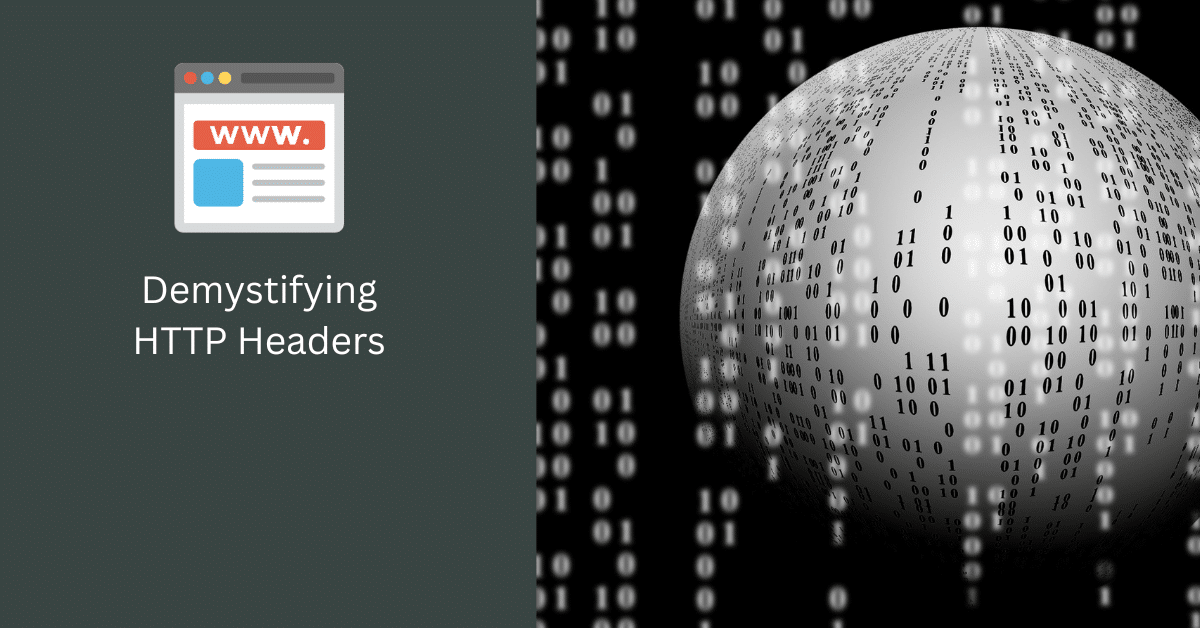
HTTP headers play a pivotal role in facilitating the exchange of crucial information between both clients and servers within the realm of web communication.
As you may already know, web scraping and automated web data collection tools, such as the Web Scraper API, have become indispensable methods for amassing copious amounts of publicly available data efficiently. After all, the adage goes, “Knowledge is power.” But how well-acquainted are you with the intricate web scraping process itself?

In the technical sphere of web scraping, which has evolved into somewhat of an art form, there exists no definitive formula for crafting the perfect web scraper. Nevertheless, there are tried-and-true resources and techniques that can markedly bolster your odds of achieving web scraping success and circumventing potential blocks from target servers.
One oft-overlooked yet potent technique involves the astute utilization and optimization of HTTP headers. This practice not only significantly reduces the likelihood of your web scraper encountering roadblocks from various data sources but also ensures the acquisition of high-quality data.
In this article, we embark on a journey to unravel the mysteries of HTTP headers, elucidating their purpose and importance. Furthermore, we delve into why the adept use and optimization of HTTP headers are indispensable when navigating the terrain of web scraping. Additionally, we explore the means to fortify your web application’s security through the judicious application of various HTTP headers. So, without further ado, let’s commence our exploration.
What Exactly Are HTTP Headers?
At its core, the function of HTTP headers is to facilitate the exchange of supplementary information between clients and servers, enriching the landscape of web communication.
However, to truly grasp the essence of HTTP headers and their primary role, let’s take a step back and delve a bit deeper into their definition and purpose.
In a nutshell, when a user initiates a request, it includes a header. These HTTP headers serve as vessels for additional data intended for the web server. In response, the web server reciprocates by transmitting specific data tailored to the client’s request. Whenever feasible, the data adheres to the software specifications delineated within the request header.
The orchestration of these HTTP headers constitutes the underpinning of seamless web interactions, facilitating the exchange of essential details between clients and servers, thereby ensuring a harmonious online experience.
Comprehensive Guide to HTTP Headers
HTTP headers serve as vital components of web communication, and they are categorized based on their specific roles and contexts within this intricate landscape:
HTTP Request Header
The HTTP request header emanates from the client, typically an internet browser, in an HTTP transaction. These headers convey a wealth of information regarding the source of the request. For instance, they divulge details about the type of browser (or the application in general) in use and its version.
HTTP request headers wield significant influence over every facet of an HTTP interaction. Websites judiciously adapt their layouts and designs based on the characteristics of the requesting device, encompassing factors such as the machine type, operating system, and the application itself. This collection of data pertaining to the source’s software and hardware is often referred to as the “user agent.” Failure to recognize the user agent can result in erroneous content display.
In instances where a website fails to identify the user agent, it might resort to one of two actions: presenting a default HTML version tailored for such scenarios or outrightly blocking the request.
HTTP Response Header
Response headers, on the other hand, are dispatched by a web server as part of its HTTP transaction responses. These headers frequently furnish information about the success or failure of the initial request, the type of connection established, the encoding used, and more. In the event that the request encounters an obstacle, HTTP response headers encapsulate error codes that categorize the issues into specific classes:
- 1xx – Informational
- 2xx – Success
- 3xx – Redirection
- 4xx – Client Error
- 5xx – Server Error
Each of these categories encompasses a plethora of situation-specific responses, and an exhaustive list of HTTP header error codes can be readily found on various online resources.
General HTTP Header
General headers are universal in scope, applying to both requests and responses, yet they do not pertain to the content itself. These headers can manifest within any HTTP message and are instrumental in governing the overall behavior of the communication. Among the most prevalent general headers are “Connection,” “Cache-Control,” and “Date.”
HTTP Entity Header
Entity headers are instrumental in providing insights into the body of the resource in question. Each entity tag is represented as a pair, exemplified by headers such as “Content-Language” and “Content-Length,” among others.
These distinct categories of HTTP headers collectively orchestrate the nuanced dynamics of web communication, ensuring the seamless exchange of information between clients and servers, and ultimately shaping the user experience online.

Illustrative HTTP Header Examples
The “User-Agent” header reigns as one of the most pivotal headers, capable of determining the success or failure of your request. Utilizing common user agents is essential to evade potential blocks during web scraping endeavors.
Certain HTTP headers can be categorized based on their interactions with proxies, a topic we’ve previously addressed in our discussion on HTTP Proxies and their configurations. Here are some headers that come into play when dealing with proxies:
1. Connection: A general header that wields control over whether the network connection remains open after the current transaction’s completion.
2. Keep-Alive: This header empowers the client to specify how the connection can be utilized, setting limits on the maximum number of requests and a timeout. For this header to take effect, the “Connection” header must be configured as “Keep-Alive.”
3. Proxy-Authenticate: This response header delineates the authentication method required for accessing resources situated behind a proxy server. It effectively authenticates the request to the proxy server, granting permission for further transmission.
4. Proxy-Authorization: A request header encompassing credentials that authenticate a user agent to a proxy server.
5. Trailer: A response header that facilitates the inclusion of additional fields at the end of chunked messages. These may comprise a message integrity check, post-processing status, or a digital signature.
6. Transfer-Encoding: This header specifies the encoding method employed to securely transfer the payload body to the sender. It applies to the message between two nodes rather than the resource itself.
These represent merely a handful of HTTP headers, and listing all possible variations would be a nearly insurmountable task. HTTP headers can be employed to dispatch an array of requests, specify preferred languages and encodings, and much more.
The Significance of Using and Optimizing HTTP Headers
The utilization and optimization of HTTP headers bear a direct impact on the type and quality of data retrieved from web servers. By leveraging these headers effectively, you can achieve two paramount objectives:
Mitigating the Risk of Web Scraper Blocks: In the ever-evolving landscape of web scraping, where website owners are cognizant of potential data scraping activities, the prudent use of HTTP headers becomes crucial. Some scrapers have the propensity to slow down websites, prompting website owners to employ every available tool for protection. This includes automatic blocking of requests emanating from fake user agents or the delivery of misleading information. Properly configured HTTP headers can help your requests appear as though they originate from organic users, significantly reducing the risk of being blocked.
Enhancing Web Application Security: HTTP headers are not solely the purview of web scrapers; web servers can harness them for bolstering web security. These headers essentially establish a contract between the browser and the developer, governed by HTTP response headers that delineate the website’s security level. Here are a few common HTTP headers that empower you to fortify your web applications:
Content-Security-Policy Header: This header furnishes an additional layer of security, safeguarding against various attacks, including Cross-Site Scripting (XSS) and code injection exploits. It defines approved content sources, enabling the browser to load them securely.
Feature-Policy Header: It grants or denies the utilization of the browser in its own frame and within content encapsulated within <iframe> elements.
X-Frame-Options Header: This header safeguards website visitors against clickjacking attacks.
X-XSS-Protection Header: Configurable to fine-tune the built-in reflective XSS protection, found in browsers like Chrome, Internet Explorer, and Safari (Webkit).
Referrer-Policy Header: Exerts control over the amount of referrer information transmitted via the Referrer header with each request.
X-Content-Type-Options Response Header: A server marker indicating that the MIME types specified in the Content-Type headers should not be altered.
You can conveniently assess the security of your HTTP headers online. Various tools are available for inspecting the HTTP security headers currently implemented on your website; all you need is the URL you wish to evaluate.
In summary, you should now possess a solid understanding of what HTTP headers are, their roles, and their significance in the realm of web scraping. We’ve also briefly delved into the realm of HTTP security headers and their functions.
Naturally, this is merely the surface, as there exists a plethora of HTTP headers worthy of consideration when engaging in web scraping endeavors. We’ve discussed five pivotal HTTP headers that every web scraper should not only utilize but also optimize to their advantage. Additionally, we recommend exploring our HTTP proxy solution to further enhance your web scraping capabilities. Feel free to explore it, and may your scraping endeavors be fruitful!

What is an HTTP header?
An HTTP header is a component of an HTTP request or response that contains additional information about the message being transmitted. It includes metadata about the data being sent, such as the content type, encoding, and more.
Why are HTTP headers important in web scraping?
HTTP headers play a crucial role in web scraping as they can impact whether your requests are successful or blocked by websites. By optimizing HTTP headers, you can mimic organic user traffic and improve data quality.
Which HTTP headers are essential for web scraping?
Some essential HTTP headers for web scraping include User-Agent, Connection, Keep-Alive, Proxy-Authenticate, Proxy-Authorization, Trailer, and Transfer-Encoding. These headers help in avoiding IP blocks and enhancing data retrieval.
How can I use HTTP headers to prevent being blocked while web scraping?
By configuring your HTTP headers to resemble those of an organic user and using techniques like rotating proxies, you can reduce the chances of being blocked by websites during web scraping.
What are HTTP security headers, and why are they important?
HTTP security headers are response headers that enhance web application security. They protect against various attacks like XSS and clickjacking. Examples include Content-Security-Policy, X-Frame-Options, and X-XSS-Protection.
How can I check the security of my website’s HTTP headers?
There are various online tools available to check the security of your website’s HTTP headers. Simply provide the URL you want to assess, and these tools will analyze and report on the headers in use.
Can improper HTTP headers lead to scraping issues?
Yes, improperly configured HTTP headers can lead to scraping issues, including getting blocked by websites or receiving inaccurate data. It’s crucial to use and optimize headers correctly for successful scraping.
What is the role of a User-Agent header in web scraping?
The User-Agent header specifies the client (browser or application) making an HTTP request. Using a common and legitimate User-Agent can help prevent websites from detecting and blocking your scraper.
Are there any HTTP headers that are specific to proxies?
Yes, headers like Connection, Keep-Alive, Proxy-Authenticate, Proxy-Authorization, Trailer, and Transfer-Encoding interact with proxies and can be crucial when using them for web scraping.
How can HTTP headers be used for data parsing and web application security?
HTTP headers can be configured to enhance web application security by implementing security headers like Content-Security-Policy and X-Frame-Options. They help protect against various web vulnerabilities.






Comments (0)
There are no comments here yet, you can be the first!